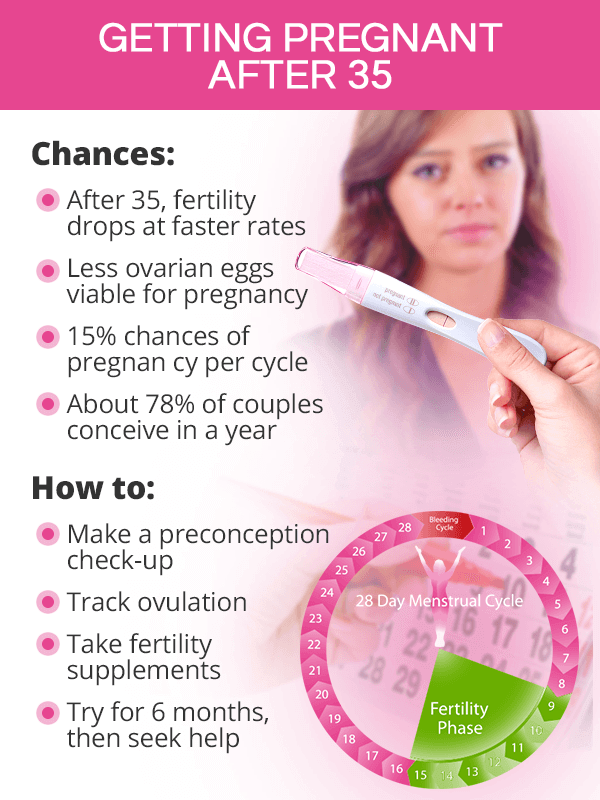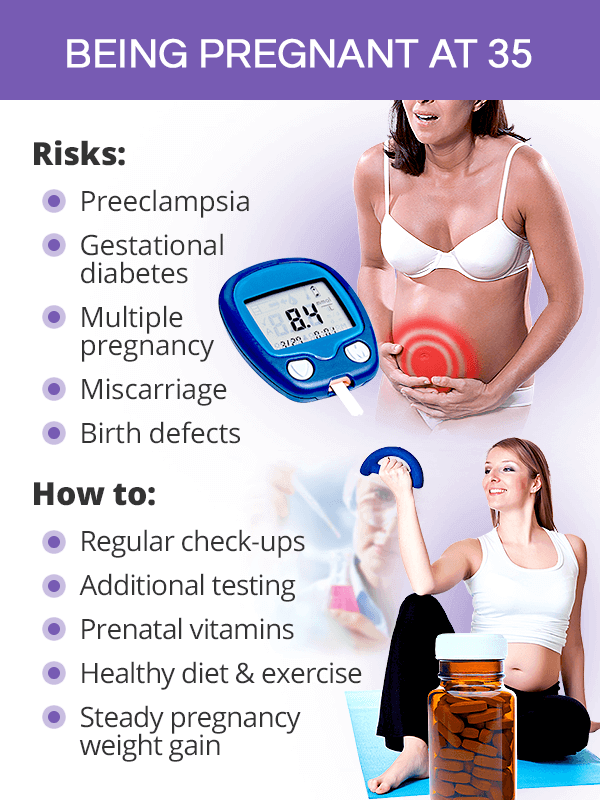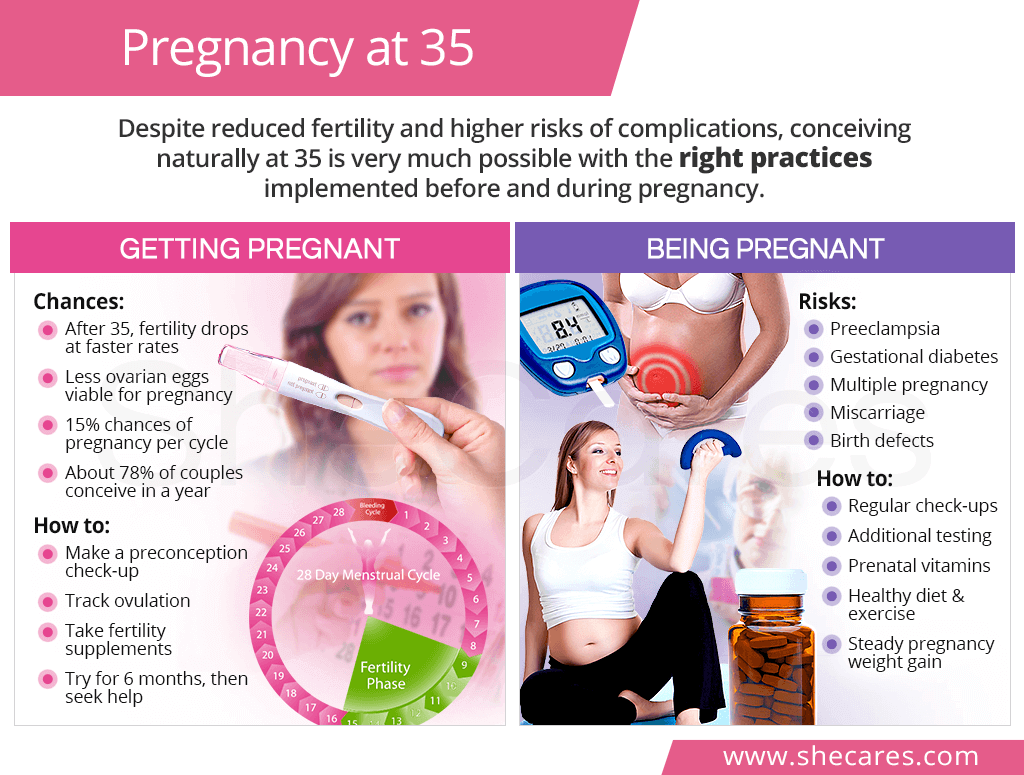Getting Pregnant after 35

For some women, getting pregnant in their mid-30s does not present any obstacles; for others, however, it might require significantly more time and effort.
Chances of Getting Pregnant at 35
A woman's fertility is constrained by her egg supply in the ovaries, referred to as the ovarian reserve.
This reserve decreases throughout a woman's life at various speeds, taking on a more drastic decline around age 35 onwards. At the same time, the chromosomal abnormalities that happen within the eggs due to aging can make them unviable for fertilization or implantation.
As a result, fertility after 35 is often compromised, resulting in the following estimated chances of conceiving:2,3,4,5
Women between the ages of 35 and 39 have a 15% chance of getting pregnant per menstrual cycle, in comparison to a 25% chance per month in those in their 20s.
About 78% of women in mid- to late-30s successfully conceive within a year, in comparison to about 96% of those in early 20s.
How to Get Pregnant at 35
Despite a rapid fertility decline, most women can still get pregnant at 35. A good approach to pregnancy preparations at 35 and boosting fertility might consist of the following steps:
Making a preconception check-up to resolve chronic conditions
Learning to track ovulation and time intercourse with one's fertile window
Taking fertility supplements, like Macafem, to resolve hormonal balance and boost pregnancy odds
Trying to conceive naturally for six months and seeking infertility treatments afterwards
Exploring assisted reproductive technologies (ARTs)
For women in their 30s who want to delay motherhood for several more years, but want to use their own eggs, fertility preservation is a viable option. However, most fertility clinics consider 35 or 36 as a cut-off age for freezing eggs.
Being Pregnant at 35

The challenges associated with pregnancy after 35 mainly concern the fact that women in their mid- to late-30s are more likely to have pre-pregnancy health conditions, such as high blood pressure or diabetes.
Additionally, women past their mid-30s are at an increased likelihood of having twins or triplets, which comes with its own set of challenges.6
Pregnancy after 35 Risks Factors
Pregnancies to women 35 and older are classified as high-risk pregnancies as advanced maternal age has been found to carry significant risks of pregnancy complications, including the following:1,6,7
- Premature birth
- Preeclampsia
- Gestational diabetes
- Cesarean section
- Low birth weight
- Miscarriage
- Stillbirth
- Birth defects
How to Have a Healthy Pregnancy at 35
Despite increased risks of complications, a healthy pregnancy after 35 is very much possible, especially when keeping in mind the following approaches:
Ensuring proper prenatal care by keeping regular doctor's appointments and undergoing prenatal testing
Eating a nutritious pregnancy diet to support the fetus and help the body withstand the rapid changes
Taking prenatal vitamins with 400 mcg of folic acid daily
Focusing on low to moderate exercise while pregnant (prior doctor's approval needed)
Practicing yoga, meditation, or breathing exercises to reduce stress during pregnancy
Gaining pregnancy weight slowly and within the recommended range
Being mindful of avoiding harsh chemicals, cat's litter, and other pregnancy precautions
Key Takeaways
Women contemplating having children after 35 often approach their conception efforts with more stress and pressure due to the fact they are automatically labeled as high-risk. Right away they are bombarded with findings that the passage of time is the leading cause of reduced fertility and higher risks of pregnancy complications, including premature birth, preeclampsia, or gestational diabetes. Nevertheless, with the right approaches before and after conceiving, a natural and healthy pregnancy at 35 is viable. It may consist of proper preconception check-up to use the time productively; boosting one's chances with fertility supplements like Macafem; starting prenatal vitamins one month before conceiving; and staying strong during pregnancy with wholesome diet and exercise. Preparing for getting pregnant at 35 ahead of time is the best way to reduce anxiety and approach one's pregnancy feeling in control.
Sources
- American College of Obstetricians and Gynecologists. (2014). Female Age-Related Fertility Decline. Retrieved October 16, 2018 from https://www.acog.org/Clinical-Guidance-and-Publications/Committee-Opinions/Committee-on-Gynecologic-Practice/Female-Age-Related-Fertility-Decline
- American Society for Reproductive Medicine. (2013). Volitional determinants and age-related decline in fecundability: a general population prospective cohort study in Denmark. Retrieved September 23, 2019 from https://www.fertstert.org/article/S0015-0282(13)00339-7/pdf
- Fertility and Sterility. (2014). Female age-related fertility decline. Retrieved September 23, 2019 from https://www.fertstert.org/article/S0015-0282(13)03464-X/pdf
- Human Reproduction. (1992). Accelerated disappearance of ovarian follicles in mid-life: implications for forecasting menopause. Retrieved September 18, 2019 from https://academic.oup.com/humrep/article-abstract/7/10/1342/664511
- Human Reproduction. (2002). Changes with age in the level and duration of fertility in the menstrual cycle. Retrieved September 18, 2019 from https://academic.oup.com/humrep/article/17/5/1399/845579
- Journal of Clinical Gynecology & Obstetrics. (2012). Is there a relation between maternal age and preferred mode of delivery? Retrieved September 18, 2019 from https://www.jcgo.org/index.php/jcgo/article/view/8/5
- March of Dimes. (2016). Pregnancy after age 35. Retrieved September 18, 2019 from https://www.marchofdimes.org/complications/pregnancy-after-age-35.aspx
Footnotes:
- CDC. (2017). Vital Statistics Rapid Release. Births: Provisional Data for 2017. Retrieved September 23, 2019 from https://www.cdc.gov/nchs/data/vsrr/report004.pdf
- American Society of Reproductive Medicine. (2012). Age and Fertility. Retrieved September 23, 2019 from https://www.fertstert.org/article/S0015-0282(13)03464-X/pdf
- British Fertility Society. (n.d.). A guide to fertility. Retrieved September 23, 2019 from https://www.britishfertilitysociety.org.uk/fei/at-what-age-does-fertility-begin-to-decrease/
- Fertility Network. (n.d.). Age and fertility. Retrieved September 23, 2019 from https://fertilitynetworkuk.org/fertility-faqs/factors-affecting-fertility/age-fertility/
- American College of Obstetricians and Gynecologists. (2018). Having a Baby After Age of 35. Retrieved September 23, 2019 from https://www.acog.org/~/media/For%20Patients/faq060.pdf
- Mayo Clinic. (2017). Pregnancy after 35: Healthy moms, healthy babies. Retrieved September 23, 2019 from https://www.mayoclinic.org/healthy-lifestyle/getting-pregnant/in-depth/pregnancy/art-20045756
- American Diabetes Association. (2006). Maternal Age and Prevalence of Gestational Diabetes Mellitus. Retrieved September 23, 2019 from https://care.diabetesjournals.org/content/29/4/948
- CMAJ. (2019). Risk of severe maternal morbidity associated with cesarean delivery and the role of maternal age: a population-based propensity score analysis. Retrieved September 23, 2019 from https://www.cmaj.ca/content/190/18/E556
